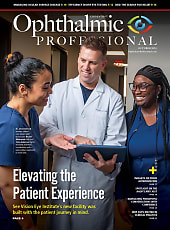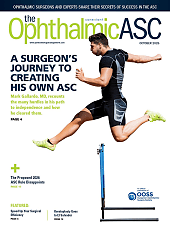PRESENTATIONS FROM THE RETINA SOCIETY
What Lies Beyond VEGF in the Treatment of PDR and DME?
Highlights from the Annual Charles L. Schepens Lecture.
Will retinal specialists someday be able to look beyond anti-vascular endothelial growth factor (VEGF) therapies for more effective ways to treat diabetic retinopathy? Lloyd Paul Aiello, MD, PhD, of the Joslin Diabetes Center and Harvard Medical School argued that this will be the case, when he presented the annual Charles L. Schepens Lecture at the Retina Society Annual Scientific Meeting in Boston. Dr. Aiello's talk, "Beyond VEGF: VEGF-independent pathways and their implications for the treatment of diabetic eye disease," focused on the role of VEGF in proliferative diabetic retinopathy (PDR) and diabetic macular edema (DME), the effect of anti-VEGF drugs in these diseases, the elucidation of VEGF-independent pathways, genetic approaches and advances, and implication for future therapies.
CURRENT THERAPIES
Dr. Aiello began by discussing the efficacy of laser photocoagulation for PDR, the current gold standard, saying, "It's effective, but clearly not perfect." There were 2151 papers on VEGF published in 2006, he told the audience, and there are currently 10 antiangiogenic drugs on the marmarket, with another 43 in clinical trials. Furthermore, he said, there are 68 clinical trials on the treatment of diabetic retinopathy (DR) currently enrolling in the United States.
| Lloyd Paul Aiello, MD, PhD, is director of the Beetham Eye Institute, head of the section of eye research at the Joslin Diabetes Center in Boston, and associate professor of ophthalmology at Harvard Medical School in Boston. He is a consultant for Eli Lilly and OSI. |
Dr. Aiello then spoke briefly about the anti-VEGF agents being used to control DR and DME. Pegaptanib sodium (Macugen, OSI/Pfizer), bevacizumab (Avastin, Genentech), and ranibizumab (Lucentis, Genentech), he said, appear to have limited adverse short term effects, but also limited duration of action. Initial DME studies suggest that there is some improvement in visual acuity with these drugs, and some reduction in retinal thickening. In contrast, Dr. Aiello noted that PDR is "markedly responsive" to anti-VEGF treatment. "Although some effect appears to be present." he said, these drugs' effectiveness for DME is less.
So, Dr. Aiello, asked, while VEGF is undoubtedly important in diabetic retinal disease, is it "the whole story?" The answer is likely no. First, Dr. Aiello discussed proteomics, ie, the role of proteins in PDR and DME. Drawing on recent work at Joslin, he said they have identified a comprehensive proteomic vitreous composition in 3 groups: (1) patients without diabetes; (2) patients with diabetes but no DR; and (3) patients with active PDR with DME. The identification of the DKK3 protein has led Dr. Aiello and others to hypothesize that DKK3 might be an endogenous inhibitor of angiogenesis. In tests conducted on diabetic animals, DKK3 reduced VEGF-induced effects in the eye.
Dr. Aiello then turned to a 2005 article in the New England Journal of Medicine that discussed the role of erythropoietin, a glycoprotein important in the production of hemoglobin, in treating DR. He quoted from the paper: "Erythropoietin is a potent ischemia-induced angiogenic factor that acts independently of VEGF during retinal angiogenesis [in PDR]." Dr. Aiello also cited a 2007 article in Nature Medicine that used a proteomic approach to PDR and identified the enzyme carbonic anhydrase, which plays a role in retinal vascular complications in diabetes. They successfully tested a hypothesis by which carbonic anhydrase appeared to mediate diabetes-induced permeability of the blood-retinal barrier in a VEGF-independent manner.
INDEPENDENCE FROM VEGF
Finally, Dr. Aiello emphasized the implications of VEGF-independent pathways in PDR and DME. With PDR, there is an apparent marked sensitivity, implying a primary role for VEGF; in the case of DME, the responses are more variable and less sensitive, implying not only that VEGF-independent pathways play a role in DME, but also that multitherapy may ultimately be the best intervention.
Dr. Aiello closed his presentation by discussing the Joslin 50-Year Medalist Study, which awarded over 2500 medals to patients with a documented history of type 1, insulin-dependent diabetes for at least 50 years. These patients have been invaluable as study subjects because of their unique diabetes exposure and provided a positive note on which Dr. Aiello could close, showing that people are surviving longer with diabetes than in the past. RP








